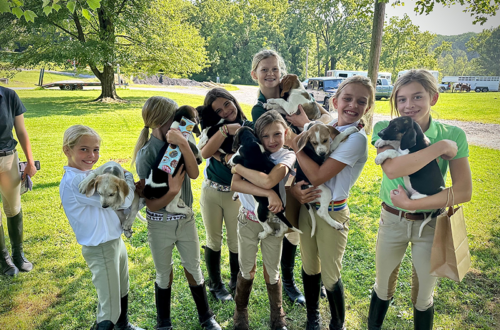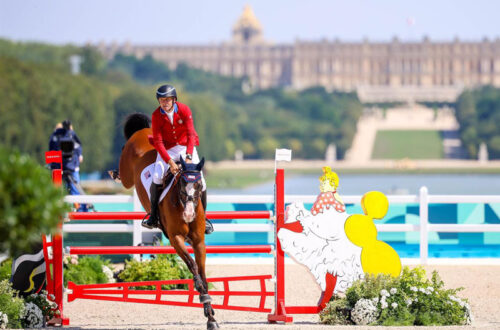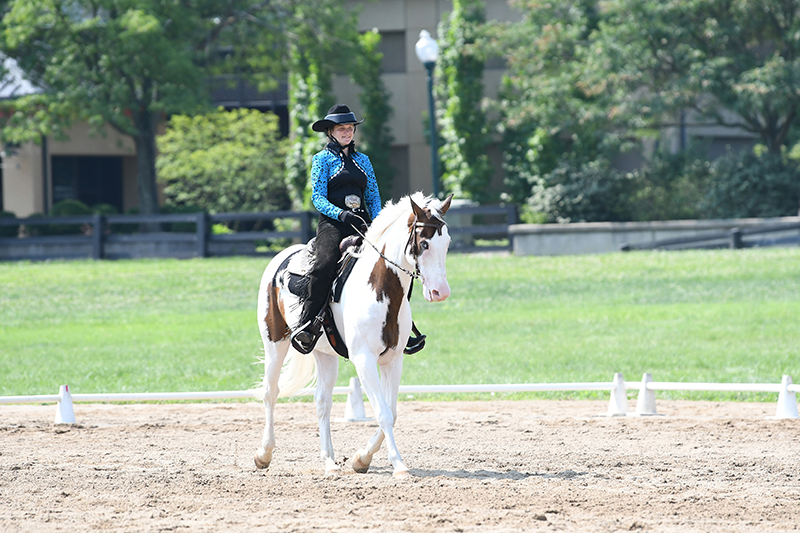
Dancing with a Western Flair
By Sarah Evers Conrad, USPC Marketing and Communications Director
If you love Dressage or want to find new ways to further your partnership and connection with your horse, there’s now a new opportunity to do so in Pony Club, while also attaining the knowledge in Horse Management and all the benefits of the Pony Club curriculum along the way. In response to the popularity and growth of Western Dressage, The United States Pony Clubs, Inc. has added a new Western Dressage certification track. The new track allows riders interested in Western Dressage to specialize in this fun and exciting discipline and to earn certifications starting at the beginner level (D-2) and progressing up to the intermediate level (C-2).
USPC hopes to add advanced (national-level) certifications to Western Dressage, from C-3 on up to the
A level, in the near future. “Development of the C-3, B, and A Standards are planned and will be driven forward, in part, by members attaining the C-1 and C-2 certifications,” said Shelley Nevins, Regional Supervisor of the Lake Shore Region and a USPC Board of Governors member. “A member can move laterally to the Western Dressage track the same as any other track, or they can choose to start at a lower level if that is what the horse and rider partnership aligns for based on the skills required.”
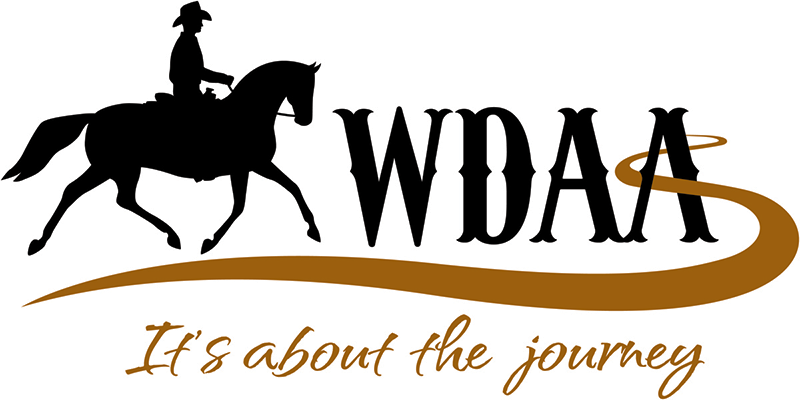
The USPC Western Dressage track aligns with the Dressage track while reflecting the Western Dressage Association of America’s (WDAA) test expectations. WDAA is the largest organization in North America promoting Western Dressage and is the United States Equestrian Federation (USEF) discipline affiliate.
“Western Dressage is very accessible to all ages of riders and types of mounts, which makes this an exciting opportunity for Pony Club,” said USPC Instruction Services Director Connie Jehlik. “Many of us grew up riding western and switched to English or vice versa, and the ability to learn or compete in either discipline in Pony Club gives our members options, which we are thrilled about.”
There is a lot of crossover between Dressage and Western Dressage, and the WDAA mission is to build an equine community that combines the Western traditions of horse and rider with classical Dressage. WDAA honors the horse, values the partnership between horse and rider, and celebrates the legacy of the American West.
What is Western Dressage?
Western Dressage is the art of riding and training a horse in a manner that develops obedience, flexibility, and balance, according to the WDAA.
Dalles Lee, an H-A alum of Tennessee Valley Pony Club, has served as a Chief Horse Management Judge in multiple disciplines, including Dressage and Western Dressage. She explains the appeal of Western Dressage.
“Western Dressage integrates the historically validated principles of Dressage with the best of western working horse tradition,” described Lee. “It is a systematic and progressive system of training for the western horse and rider in traditional stock tack with the purpose of enjoying a safe, pleasurable, versatile, and useful working horse.”
Whether your ultimate goal is in the show pen, barrel racing, or trail riding, Lee believes riders can discover the benefits of Western Dressage in the development of their horse and their partnership.
While there are many similarities between Dressage and Western Dressage, such as the development of balance, cadence, and carriage, along with the general fundamental principles, the hallmarks of a Western Dressage horse include usefulness, rideability, willingness, safety, pure gaits, lightness, and the ability to remain calm and steady.
The Western Dressage rider should demonstrate the following attributes: attentive; tactful; use of clear, effective, subtle, and light aids; riding with a confident seat; and having light and responsive hands.
Both Dressage and Western Dressage wish to create a better horse and rider with the use of structured and focused training and progressive physical and mental development, according to Lee.
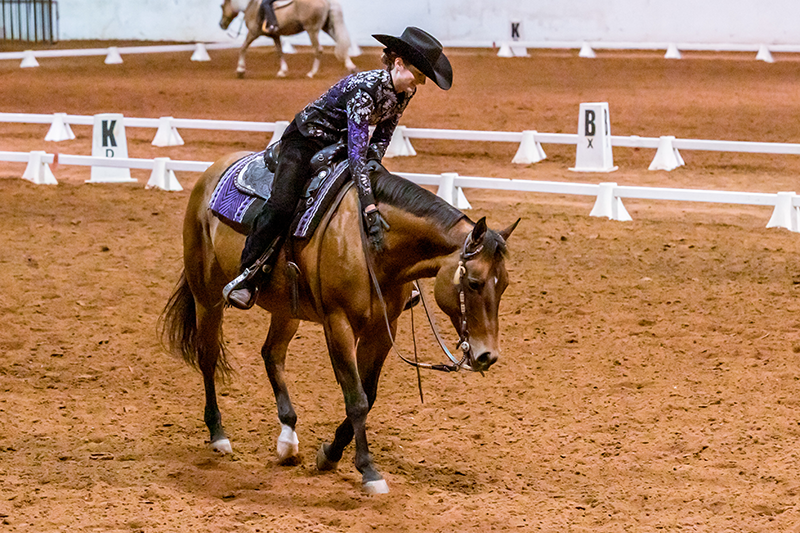
However, she explains how they differ in the execution of those fundamental elements. “As the horse and rider progress through the levels of Western Dressage, the test elements become increasingly reflective of movements, maneuvers, and duties asked of a western horse,” she said. “The Western Dressage horse is evaluated with the conformation and movement of today’s western horses in mind.”
The levels are presented differently from Dressage. In Dressage through the USEF or the United States Dressage Federation (USDF), there are the following levels: Intro, Training, First Level, Second Level, Third Level, Fourth Level, Prix St. Georges, Intermediate I and II, and Grand Prix. The WDAA levels as they correspond to the USPC certification levels are as follows:
- WD Intro Level (walk/trot only) = USEF Intro Level
- WD Basic Level = USEF Training Level
- WD Basic Level test 1 = USPC D-2
- WD Basic Level test 2 = USPC D-3
- WD Basic Level test 3 = USPC C-1
- WD Level 1 = USEF First Level; WD Level test 1 = USPC C-2
- WD Level 2 = USEF Second Level
- WD Level 3 = USEF Third Level
- WD Level 4 = USEF Fourth Level
- WD Level 5 = USEF Prix St. George
There are also WDAA Lead Line and Therapeutic Riding Tests. Tests in Western Dressage are online here. Each level has multiple tests that build upon each other and introduce new movements. In addition, like in standard Dressage, USPC also allows freestyle tests in Western Dressage where riders get to be creative and wear costumes.
Benefits of Western Dressage
One of the best parts of Western Dressage is that any horse, pony, or mule can compete, including gaited and non-traditional breeds. The WDAA Breed Alliance partnerships include stock breeds such as Quarter Horses, Paints and Appaloosas, as well as Arabians, Morgans, American Saddlebreds, Friesians, Gypsy Vanners, Tennessee Walking Horses, and others.
“This is a fantastic sport,” said USPC National Examiner Anne Moss during her presentation at the annual USPC National Examiners Virtual Seminar. Moss is also an “R” judge for Dressage, Western Dressage, and Sport Horses. “It’s an entry point for anyone at any age on any horse, and I just think that is very exciting.”
“If you have any talented dressage horse/rider combination, if their horse is willing to go in western tack, which just means basically being able to carry a western saddle comfortably, because you can still use a snaffle bit, then there’s a huge opportunity for a lot of people to cross over into that sport quite easily and be quite successful…and you get a fun outfit,” she continued.
Nevins’ favorite part of Western Dressage is seeing western-type horses and riders being able to enjoy the sport of Dressage and benefit from the overall concepts. “I also love that in Western Dressage
competition, stock-type horses are expected to move correctly, but are not being asked to show the same
type of movement as a warmblood that was bred for standard Dressage.”
Nevins points out that she’s seen many non-stock breeds, like Morgans, Arabians, Saddlebreds, and even
draft horses and ponies, competing in Western Dressage.
Gaited horses are also encouraged to participate and are allowed to perform an intermediate or saddle gait in place of the jog in WDAA tests. This gait is a four-beat lateral or diagonal gait, and footfalls should not change throughout the test.
“This true four-beat gait the horse performs should be able to be ridden in a working, lengthened, free, and collected manner as the Western Dressage test calls for,” explained Lee.
Lee loves the camaraderie in the discipline. “If you ever go to a Western Dressage competition or one that has both classical and Western Dressage, you will find that unlike classical Dressage, the Western Dressage people all line up along the arena and watch each other. The camaraderie among complete strangers at a Western Dressage show is just so nice and something you do not generally see.”
Nevins added that Western Dressage can be a way for clubs/centers to attract new members and supporters, as well as expanding horizons for current members. “Adding Western Dressage to your education curriculum increases the membership’s understanding of the larger equine community and potentially exposes them to something they may not have been aware of as an option,” she said.
Getting Started
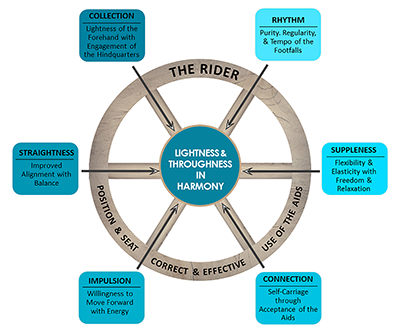
Understanding Western Dressage includes studying the Training Wheel, which has all of the facets of the Dressage Training Pyramid but adds more responsibility on the rider to achieve the ultimate goal of “Lightness and Throughness In Harmony,” (see right) which is in the hub of the wheel. The rim holds all training elements together, and the rider is responsible for ensuring that all spokes of the wheel are equally developed, said Moss. WDAA describes Throughness In Harmony as a rider “sitting perfectly still and quietly communicating with a horse, yet they are both in complete sync with each other as they perform movements.”
To get started, you’ll need the right western tack and apparel, a willing horse, and a flat area for an arena.
“Members should let their club leadership know that they are interested in pursuing this track so that leaders can support education and plan for testings,” advised Nevins.
Riding Arena Specifications: Arena dimensions are important in dressage for the various movements, and arenas vary by small (20 meters x 40 meters) for Basic Level (D-2 to C-1) or large (20m x 60m) for Level 1 (C-2) and above. Letters will need the proper placing, but various materials could be used—from cones to buckets to blocks, etc. The following acronyms can help you remember where to place your letters, starting with A at the entrance: for small arenas, All King Edward’s Horses Can Master Big Fences; for large arenas, All King Von Edward’s Small Horses Can Master Really Big Pink Fences.
To Practice: Western Dressage tests include circles, half circles, and serpentines, just like in Dressage, so you’ll want to practice with your horse to perfect those movements at the various gaits. Speaking of gaits, learning what type of movement, impulsion, and collection is needed for each gait is important. In addition, terminology may be different than you’re used to. For example, the trot is called the jog, and it is more like a working trot than a western pleasure jog, which is slower. Western Dressage is a great way to look at the different types of jog (or trot) that a horse can do, such as collected versus extended. And the canter is called a lope.
“Do not get overwhelmed by the elements and requirements of the upper levels,” said Lee. “Start at the beginning and work your way through at a pace appropriate to you and your mount.”
Western Wear: As for Western Dressage apparel, helmets are still required by USPC. It doesn’t necessarily have to be a western-looking helmet, although there are a variety of stylish western helmet options out there. Other attire is detailed in the USPC rulebook, and you do not need fancy tack or clothing.
Know Your Equipment: You’ll need to study the USPC and USEF rulebooks to see what is allowed. A western-type headstall must be used and can include a western cavesson, or pencil bosal, Hackamore, a western-style bitless bridle, or a western two-rein bridle (per the USPC rulebook). Snaffle or curb bits are allowed.
In addition, it’s important to learn how to use a curb bit correctly, if that is your bit of choice, and how to hold the reins, depending on the type you have. Split reins, mecate reins (only allowed with a snaffle) or Bosal, roping (closed or loop/connected) reins, buckled reins, and romal reins. All reins must have a breakaway option. You’ll need to learn how to ride with one or two hands, depending on the type of reins and bit being used (see Article 49 of the USPC rulebook). It may be good practice to study the various types of equipment.
You’ll want to ensure your Western saddle is well-fit to provide a balanced seat, and Moss warned against barrel racing saddles, which are built more for speed versus showing a balanced seat. The rulebook provides more specifics on saddles, as well, and discusses other permitted equipment.
Moving to Competitions: While the certification track is new, Western Dressage has been a competition discipline in USPC for a while—shortly after the Western certification track was added in 2012. Since this time, it has been offered as a competition option at an increasing number of regional rallies, as well as USPC Championships. Members who are eligible and meet the requirements of the current USPC Western Dressage rulebook at their regional rally may go on to compete at USPC Championships, held every two years at the USPC Festival. In 2025, USPC will also be offering virtual competitions in Western Dressage.
Western Dressage enthusiasts can also join the WDAA and compete in WDAA shows as well as the WDAA World Championships, along with online WDAA shows.

While it may seem like a lot to learn, if you take it step by step and find the right mentors and instructors, you can have fun and be successful in Western Dressage. As it has grown across the U.S., Western Dressage is sure to grow within the United States Pony Clubs world. So if we’ve piqued your interest, ask your DC or CA about your options at your next meeting.
Happy dancing!
Must-Read Resources
To understand more about Western Dressage, you’ll want to review the Standards of Proficiency and Test Sheets, available on www.ponyclub.org. Simply log in, mouse over Education and click on Standards and Test Sheets.
You’ll also want to review the Western Dressage rulebook here to learn more about the tack and equipment that can be used, etc. In addition, the WDAA tests here are what is used by USPC, so you’ll need to study and practice those. And finally, the WDAA website offers a plethora of resources.
Lee also recommends those interested should contact discipline resource people listed in the USPC Western Dressage newsletter, which is available with the rulebook at the link above. She also suggested visiting the dressage resource page on the USPC website and going to see Western Dressage at a rally.
Tips for Starting a Western Dressage Program in Your Club/Center
For those wanting to start a Western Dressage program within their club or center program, you would start it just like any other program, said Dalles Lee, USPC Chief Horse Management Judge in Dressage and Western Dressage.
“Western Dressage is a great discipline that more riding centers and lesson programs may utilize when they realize it is available,” said Lee. “There are plenty of members and potential members out there that may be riding a gaited horse, draft horse, or a horse that traditionally do not score well because of their conformation or way of going in classical Dressage, and these horses are welcomed with open arms in Western Dressage.”
- Leaders should review the rulebook for creating a dressage arena and follow the specifications listed for arenas, tack, equipment, and apparel.
- In addition to the rulebook, make sure you study the USEF Western Dressage rulebook, the USPC Standards of Proficiency, and materials from the Western Dressage Association of America (WDAA).
- Unmounted lessons can showcase the various types of western tack and equipment and how to use it. In addition, Shelley Nevins, Region Supervisor for the Lake Shore Region, recommends looking for the differences and similarities between Dressage and Western Dressage or differences in tack during an unmounted meeting.
- For more visual sources of education, check out the WDAA’s YouTube channel to learn more about the discipline, scoring, and what judges are looking for.
- Seek out Western Dressage experts for a clinic.
- “Many Western Dressage judges and competitors are happy to come and educate groups about their sport,” said Nevins. WDAA has a list of judges accessible on their website that is an excellent place to start if you don’t know anyone specifically within your area.”
- Many Dressage shows offer Western Dressage classes where leaders could connect with local resources, or it could be a field trip for leaders with their members to watch and learn more.
- In addition, while you might think Western Dressage would need its own rally, Nevins points out that it is very easy to offer Western Dressage tests at a standard Dressage rally, especially since most Dressage judges are comfortable and capable to judge a WDAA test.
This article on Western Dressage was originally published in the 2024 Spring issue of Discover USPC magazine. Read more content from that issue.




